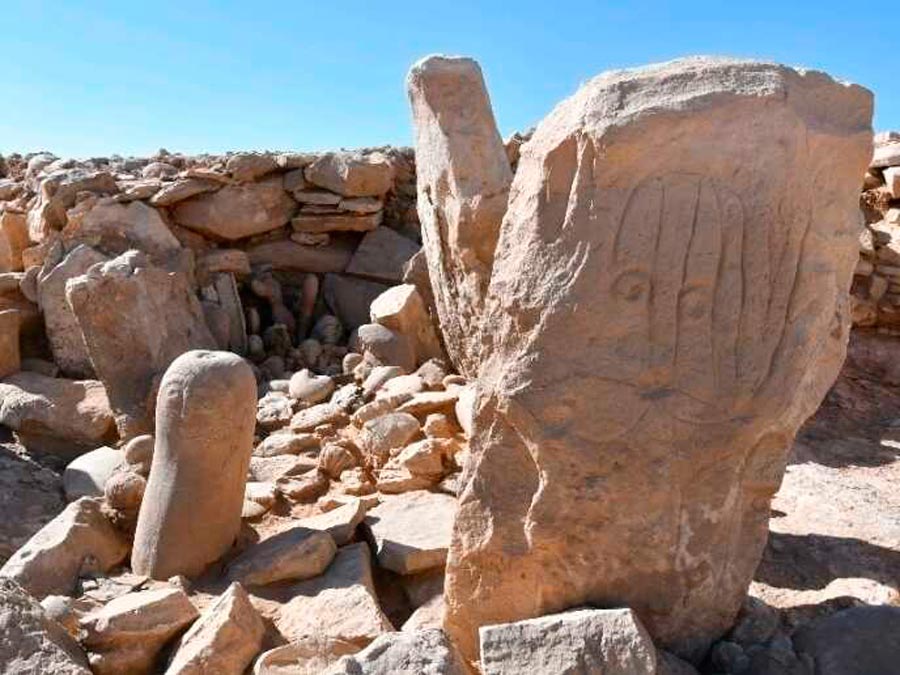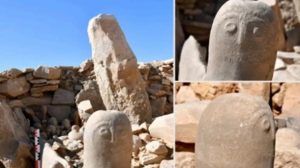East Jordan Desert Pre-Pottery “Perfect” Neolithic Shrine

A team of Jordanian and French archaeologists have found an exceptionally well-preserved and intact Neolithic shrine at a remote prehistoric hunting campsite in Jordan’s eastern desert that dates back roughly 9,000 years, reports NPR. This places the shrine in the late Pre-Pottery Neolithic era, a Neolithic culture mostly existed in upper Mesopotamia and the Levant, from circa 10,800 to 8,500 years ago (8800–6500 BC). The team comprised archaeologists from Jordan’s Al Hussein Bin Talal University and the French Institute of the Near East.
A Remarkably Well-preserved Neolithic Shrine Campsite
The shrine was discovered at a Neolithic campsite near large structures that were mass gazelle traps in a remote part of Jordan. These structures, known as “desert kites,” are thought to have been used to enclose wild gazelles that were slaughtered for meat. Such traps, that are made of two or more stone walls that converge towards an enclosure, are common across the deserts of the Middle East. The structures are scattered across southwest and central Asia, with some of the oldest believed to be in Jordan’s Badia region.
Unexpected Statues of Mythological Goddess Unearthed in Jordan
Bizarre Comical Frescoes Complete with Speech in a Lost Hybrid Language Found in Jordan Tomb
Jordanian archaeologists carefully moving stones and documenting at Jordan’s Neolithic shrine. Note the rounded pillar stone in the lower righthand corner.
What astonished the archaeologists was that that the site is very well preserved despite its age. Jordanian archaeologist Wael Abu-Azziza, who is co-director of the project, is quoted by Al Jazeera as saying, “The site is unique, first because of its preservation state. It’s 9,000 years old and everything is almost intact.” This means the archaeologists will have access to remarkably complete material from the site from which to learn more about the Neolithic culture of the region.

Clearly the Shrine of a Neolithic Hunting Culture
The new Jordanian Neolithic shrine consists of two large standing stones carved with anthropomorphic figures. One of the figures is accompanied with a depiction of the “desert kite” structure. Apart from the stones, the complex contained an altar, sea shells, a hearth, and a miniature model of a gazelle trap.

A handout picture made available by the Jordanian Antiquities Authority shows recently-discovered antiquities linked to hunter-gatherers and dating back to the Neolithic era (4500-9000 BC) in the Jordanian Badia, south-east of the Kingdom. (Alarabiya)
According to a statement from the research team, quoted in Al Arabiya, the discovery of the shrine, “sheds an entire new light on the symbolism, artistic expression as well as spiritual culture of these hitherto unknown Neolithic populations.”
That the shrine was located so close to the gazelle traps and contained representations of the traps themselves clearly reveals the centrality of hunting to the inhabitants of the site. They were likely specialized hunters who depended largely on the traps for their subsistence in this harsh climatic region with sparse vegetation. As the statement from the archaeological team said, the traps were “the centre of their cultural, economic and even symbolic life in this marginal zone.”

Lifting one of the two Neolithic standing stones that had been inscribed with anthropomorphic figures in the eastern desert of Jordan.
Humanlike Representations in Neolithic Jordanian Cultures
One of the best-known Neolithic sites in Jordan is the Ain Ghazal near Amman. Ain Ghazal again belongs to the Pre-Pottery Neolithic age. The inhabitants of Ain Ghazal consumed a varied diet but appeared to have eaten gazelles in substantial quantities.
Ain Ghazal is most famous for a set of plaster anthropomorphic statues that were found buried in pits near some buildings that are believed to have had ritual functions. These half-size human figures were made of white plaster around a core of bundled twigs. They had clothes and hair, and, in some cases, even ornamental tattoos painted on them. The eyes are made of cowries and have bitumen pupils. In all 32 such figures were found, some full figures, some busts and a couple of heads.
While these Ain Ghazal figures are very different from the figures found etched on stones at the latest Neolithic shrine and hunting camp site, both have been found at or near structures that had a ritual function.
Given this commonality, is it possible to suggest that anthropomorphism had ritual significance across Pre-Pottery Neolithic cultures in Jordan? Only a more complete analysis of the site by the experts in the days to come will be able to provide an answer.
The Jordan desert has for thousands of years been home to Bedouin tribes and is archaeologically very rich. It is dotted with countless archaeological sites, five of which have a UNESCO World Heritage tag. The most famous of these is Petra, the Nabatean city carved into the red sandstone in the fourth century BC.